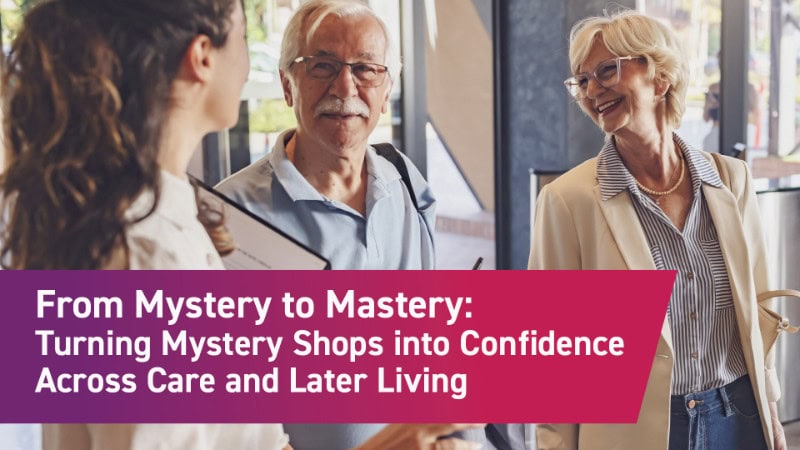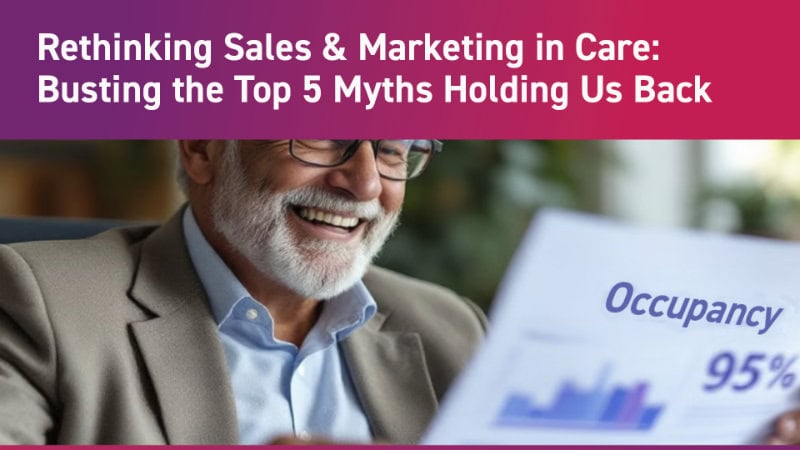Imagine a world where every potential resident finds the perfect home swiftly and seamlessly – sounds ideal, doesn’t it? In the later-living sector, speeding up the move-in process isn’t just about business – it’s about making life transitions smoother for people. It’s about ensuring that every individual finds comfort and care without unnecessary delays.
Improving sales velocity is crucial for maintaining healthy occupancy rates and achieving revenue goals, as well as for enhancing the overall experience for residents and their families. Let’s explore how boosting sales velocity can benefit your later-living community and the residents you serve and look at some effective strategies to achieve this.
Understanding Sales Velocity
Sales velocity measures how quickly prospective residents can move through your sales pipeline. It’s crucial in the later-living sector because it directly impacts occupancy rates and the efficient use of resources like staff time and facilities. More importantly, it eases the transition for potential residents and their families, reducing stress and ensuring a better overall experience.
By understanding and optimising your sales velocity, you can identify bottlenecks in your sales process, improve efficiency, and ultimately increase revenue. Faster sales cycles mean quicker move-ins, which helps maintain a steady cash flow and keeps your community thriving.
Strategies to Boost Sales Velocity:
1. Start Your Outreach Early
Launching your outreach efforts well ahead of time sets the stage for a successful opening. Aim to begin at least 12 -18 months before welcoming your first residents where possible. Here’s how to get started:
- Pre-Launch Events: Create excitement with pre-launch events. Invite potential residents, their families, and influential local people to see what your community offers. Highlight unique features and amenities to leave a lasting impression. Consider hosting themed events or open days that showcase different aspects of your community life, from dining experiences to wellness programmes.
- Local Networking: Be present at local networking events, chamber of commerce meetings, and industry conferences. Building relationships with professionals, estate agents, and healthcare providers can lead to valuable referrals.
2. Build Trust and Credibility
Trust is key when it comes to potential residents and their families choosing a later living community. Here’s how to build that essential trust:
- Community Involvement: Show your commitment by participating in local initiatives. Sponsor charity events, volunteer at elderly care community centres, and collaborate with community organisations. This involvement helps build credibility and trust within the community. Consider partnerships with local schools for intergenerational programmes that bring joy to residents and students alike.
- Educational Workshops: Host informative workshops on topics like financial planning, health and wellness, or downsizing. Position your community as a knowledgeable resource, offering valuable information and support.
- Engage with Local Groups: Connecting with local groups and activities that older people enjoy can significantly enhance your outreach. Here are some ideas:
- Sports Clubs: Form partnerships with local sports clubs such as golf, bowling, or tennis organisations. Sponsor events or offer special promotions to club members. This visibility can attract active and engaged potential residents. Hosting friendly competitions or community sports days can further embed your community in local sporting circles.
- Hobby Groups: Many older people participate in chess clubs, knitting circles, or gardening clubs. Attend their meetings, share information about your community, and offer tours. Being visible in these social settings can generate interest and referrals. You might even host special interest events or hobby fairs at your community to invite these groups in.
3. Hold Regular Events
Organising regular events tailored to the interests and preferences of your target audience can make your community more appealing to potential residents. Here’s how to leverage events effectively:
- Tailored Events: Focus on creating events that resonate with your prospective residents and their families. Do they enjoy ballet, cricket, or perhaps gardening? Hosting events that align with their interests can create a personal connection and make your community more attractive. For example, consider inviting a local ballet troupe for a performance or organizing a cricket match for the sports enthusiasts.
- Quarterly Big Events: Plan and advertise significant events every quarter. These can be large-scale celebrations like summer picnics, Halloween parties, or holiday dinners. Such events not only create a festive atmosphere but also provide an excellent opportunity for potential residents and their families to experience the vibrant community life first-hand.
- Monthly Smaller Events: In addition to the big quarterly events, hold smaller, more intimate gatherings monthly. Coffee mornings, book clubs, or craft sessions can offer prospective residents a glimpse into the day-to-day activities and the warm, welcoming environment of your community.
- Health and Wellness Activities: Organise health fairs, fitness classes, and wellness seminars. These activities not only enhance the well-being of your current residents but also showcase your commitment to a healthy lifestyle to prospective residents.
- Cultural and Educational Events: Host events that cater to diverse interests, such as art exhibitions, music performances, or guest lectures. These events can attract a wide audience and demonstrate the vibrant and enriching life your community offers.
- Family Days: Schedule family-oriented events where residents can invite their relatives for a day of fun and bonding. These events foster a sense of community and belonging, making your facility a more attractive option for families.
- Open Days: Regularly host Open Days where potential residents and their families can tour your facilities, meet the staff, and get a feel for the community. Advertise these Open Days across all your marketing channels, including your website, social media platforms, and email newsletters, to ensure maximum visibility and attendance.
4. Personalise Your Approach
Personalisation is key to making meaningful connections with potential residents and their families. Here’s how to add a personal touch:
- Tailored Communication: Send personalised letters, emails, or even handwritten notes to potential residents and their families. Highlight how your community meets their specific needs and interests. Use stories and testimonials from current residents to illustrate your points and create a more relatable message.
- One-on-One Meetings: Arrange personal meetings with potential residents and their families, either at the site, their home, or somewhere neutral. Take the time to understand their concerns and preferences, and provide tailored solutions that address their unique needs. Offering virtual tours and video calls can also cater to those who cannot visit in person, ensuring no one misses out on the personal touch.
5. Utilise Digital Marketing
Having a robust online presence is essential. Here’s how to leverage digital marketing to boost your sales:
- Website Optimisation: Ensure your website is user-friendly, mobile-optimised, and filled with engaging content. Include virtual tours, resident testimonials, and detailed information about your services and amenities. Enhance the visual appeal and informational value by incorporating videos and photos. These elements not only make your website more attractive but also provide key information to reassure potential residents and their families. Showcasing day-to-day activities, staff interactions, and the vibrant community life through multimedia can help create a more comprehensive and reassuring picture of your community.
- Social Media Engagement: Actively engage with your audience on social media platforms. Share updates, success stories, event highlights, and educational content. Regular interaction on platforms like Facebook and Instagram can help build a sense of community online.
- Email Marketing: Develop an email marketing strategy that keeps potential residents and their families informed and engaged. Send newsletters with updates, upcoming events, and helpful resources tailored to their interests.
- Be Present on Online Directories: Make sure your care home is listed on popular online directories like Autumna and Lottie, which spend significant resources on keyword marketing such as ‘care home near me’ or ‘retirement village near me.’ This can enhance your visibility and make it easier for potential residents and their families to find you. Additionally, optimise your Google My Business profile to appear in local searches and provide all necessary information at a glance.
- Paid Advertising: This is a critical component of your digital marketing strategy. Use Google Ads to target keywords related to elderly care and assisted living through search and display campaigns. Run Facebook and Instagram ads aimed at adult children of elderly parents, showcasing your facilities and testimonials. Use LinkedIn ads to reach healthcare professionals and caregivers. Partner with local blogs and news sites for sponsored content about your care home. Google PPC is particularly effective in reaching potential clients actively searching for care solutions.
- Organic Advertising: Maintain an active blog with elderly care tips, success stories, and expert advice, optimising for SEO. Engage on Facebook, Instagram, and LinkedIn with regular updates, photos, and videos, responding promptly to foster a sense of community.
6. Understanding the Difference Between Marketing and Sales
Marketing and sales teams each play essential roles in driving later-living occupancy. To encourage collaboration, everyone must understand who is in charge of what area.
- Marketing’s Role: Lead Generation
- Lead Quality: Focus on generating a sufficient amount of quality leads each week or month. Quality leads are those that are more likely to turn into actual residents.
- Lead Source Attribution: It’s crucial to understand where most of your leads are coming from. Ideally, the primary source should be organic website searches.
- Website Performance: Make sure your website is well-optimised and performing efficiently. This ensures healthy traffic and higher chances of converting visitors into leads.
- Lead Advancement: Ensure that the leads generated by the marketing team are being effectively nurtured and are progressing to the point where the sales team can engage with them. This smooth transition is key to converting interested parties into residents.
- Sales’ Role: Conversions
- Speed to Lead: The community that responds fastest to initial enquiries tends to win. Ensure quick response times to boost conversions.
- Timely Follow-Up: Following up with leads in a timely and regular manner is crucial. Use a CRM system to assist in managing these follow-ups effectively.
- Personalised Tours and Next Steps: Personalise the tour experience for each prospect and secure clear next steps to improve conversion rates from enquiry to tour and tour to move-in.
- Variety of Communication Touchpoints: Engage with leads through a variety of communication touchpoints. This can include phone calls, invitations to community events, and collaborative efforts with the marketing team such as newsletters and customer testimonials.
Final Thoughts
Boosting sales in later-living communities requires a thoughtful, proactive approach. By starting early, building trust, engaging with local groups, personalising your outreach, and leveraging digital marketing, you can attract qualified leads and increase your occupancy rates. Remember, genuine connections and personalised interactions are at the heart of success.


